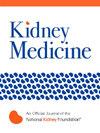Acute Kidney Injury Secondary to Pegylated Liposomal Doxorubicin-Associated Renal-limited Thrombotic Microangiopathy
IF 3.2
Q1 UROLOGY & NEPHROLOGY
引用次数: 0
Abstract
The emergence of pegylated liposomal doxorubicin (PLD) as a preferred treatment for various malignancies, because of its reduced cardiotoxicity compared with conventional doxorubicin, has raised significant interest. However, the association between PLD and thrombotic microangiopathy (TMA) remains a concerning and relatively rare complication. Here, we present the case of an 80-year-old man with metastatic Kaposi sarcoma who underwent extended PLD monotherapy, subsequently developing kidney-limited TMA demonstrated on kidney biopsy. This led to acute kidney injury necessitating hemodialysis. The patient’s clinical history, laboratory, and kidney biopsy data supported PLD chemotherapy as the primary etiologic factor for the observed kidney-limited TMA, an insidious condition with poor prognosis. This report highlights the need for vigilance and early kidney biopsy in patients with rising serum creatinine concentrations or worsening proteinuria/hematuria during PLD therapy. Understanding the mechanisms underlying PLD-induced TMA, likely involving reactive oxygen species-mediated endothelial dysfunction and platelet aggregation, remains a crucial area for future research to optimize monitoring and management strategies for this rare yet severe complication associated with PLD therapy.
聚乙二醇脂质体阿霉素相关肾限制性血栓性微血管病继发急性肾损伤
聚乙二醇化脂质体多柔比星(PLD)作为各种恶性肿瘤的首选治疗方法的出现引起了人们的极大兴趣,因为它与传统的多柔比星相比降低了心脏毒性。然而,PLD与血栓性微血管病变(TMA)之间的关联仍然是一个令人关注的相对罕见的并发症。在这里,我们报告了一例80岁的转移性卡波西肉瘤患者,他接受了延长的PLD单药治疗,随后肾活检显示其发展为肾限制性TMA。这导致急性肾损伤,需要血液透析。患者的临床病史、实验室和肾活检数据支持PLD化疗是观察到的肾限制性TMA的主要病因,这是一种预后不良的潜伏疾病。该报告强调了在PLD治疗期间血清肌酐浓度升高或蛋白尿/血尿恶化的患者需要警惕和早期肾活检。了解PLD诱导TMA的潜在机制,可能涉及活性氧介导的内皮功能障碍和血小板聚集,仍然是未来研究的关键领域,以优化这种罕见但严重的PLD治疗相关并发症的监测和管理策略。
本文章由计算机程序翻译,如有差异,请以英文原文为准。
求助全文
约1分钟内获得全文
求助全文

 求助内容:
求助内容: 应助结果提醒方式:
应助结果提醒方式:


